Polaroid introduction and industry development trend analysis
1. Polarizer: just need for display panel
Polarizer: Control the polarization direction of the beam. The role of the polarizer is to change the omnidirectional light into a single direction of polarized light. The direction of the polarized light is parallel to the direction of the transmission axis of the polarizer, and the light perpendicular to the direction of the transmission axis is absorbed.
Schematic diagram of polarizer

The polarizer is composed of multiple layers of film, and the core film PVA is responsible for polarization. The polarizer is composed of PVA film, TAC film, protective film, release film and pressure-sensitive adhesive. Among them, the PVA film that absorbs bidirectional absorption molecules is responsible for polarization. It is the core film of the polarizer and determines the polarizing performance of the polarizer. The key parameters such as transmittance and color tone, the TAC film serves to support and protect the extended PVA film.
Polaroid structure composition

Characteristics and functions of polarizer films
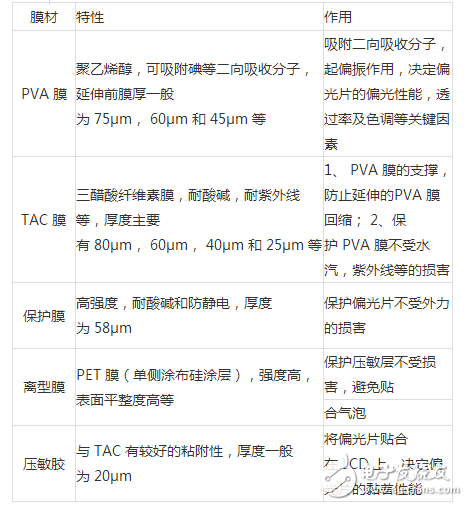
TAC membrane cleaning: The TAC membrane is treated with lye, then washed with water to remove residual lye, and finally dried and wound. This link can reduce the contact angle of the TAC film and facilitate the bonding with the PVA film. PVA film stretching and compounding: PVA film is immersed in the dyeing tank, adsorbs the two-way absorbed iodine molecules, stretches and orients the iodine molecules in the stretching tank, and is dried and combined with the TAC film to form a semi-finished polarizer. The current mainstream processes of polarizers are iodine production technology and wet stretching process, and PVA film extension is the core link. The process of polarizing film is divided into iodine system and dye system according to the adsorbed bidirectional absorbing molecules, and it is divided into dry process and wet process according to the drawing process. At present, the mainstream processes are iodine production technology and wet stretching process. The main production links include TAC film cleaning, PVA film extension and compounding, pressure sensitive adhesive coating and release film compounding, of which, PVA film extension is the core Link.
Pressure sensitive adhesive coating and release film compounding: Coat pressure sensitive adhesive on the release film, evaporate the water in the adhesive, and then affix it to the semi-finished polarizer and wind it. Finally cured to form a polarizer.
Polaroid iodine and wet stretching process flow diagram: TAC film cleaning, PVA film extension and compounding, pressure sensitive adhesive coating and release film compounding
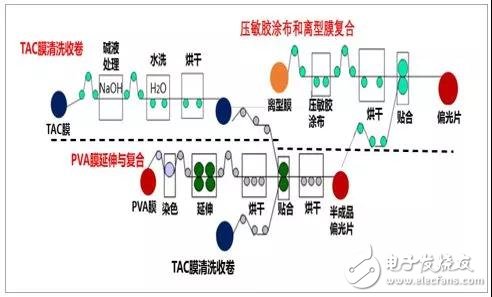
Upstream of polarizers: The core raw materials are PVA and TAC films, and Japanese companies monopolize the global market. The core raw materials of polarizers are PVA film and TAC film, which account for about 60% to 70% of the total cost.
At present, the main suppliers of the two film materials are Japanese and Korean companies. The main supplier of PVA film is Kuraray Japan, accounting for 70% of the global market share. Domestic Anhuiwei can provide PVA film for black and white polarizers; the main TAC film The suppliers are Japan Fujifilm and Konica, and Lucky has supplied some TAC films for domestic polarizer companies.
Downstream of polarizer: widely used, display panel is the main application scenario. Polarizers are widely used in consumer and industrial electronic display panels, such as mobile phones, computers, LCD TVs, automotive electronics, medical equipment and instrumentation, etc. Other application scenarios include sunglasses, anti-glare goggles, photography equipment Filter, light quantity controller, etc.
Polarizer industry chain
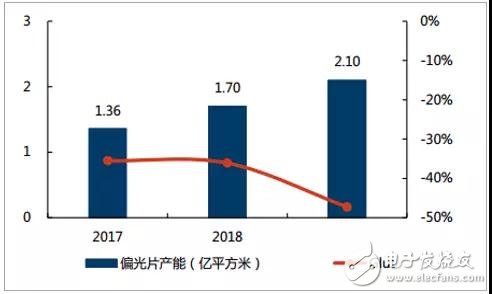
The polarizer is a necessary component for the imaging of the display module. The cost of polarizers accounts for about 10% of LCD raw materials. Two polarizers are required in the LCD module, which are located on both sides of the glass substrate. The lower polarizer is responsible for converting the backlight beam into polarized light, and the upper polarizer is responsible for analyzing the polarized light after the liquid crystal is electrically modulated. The liquid crystal module imaging relies on polarized light, so the screen cannot be displayed without any polarizer.
Liquid crystal display module structure, OLED display panel structure and LCD panel imaging principle
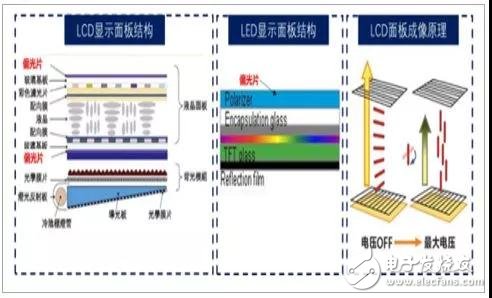
LCD panel raw material proportion structure diagram
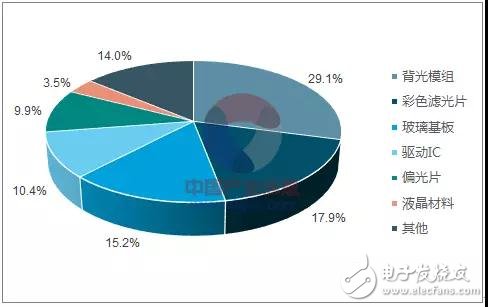
2. The continuous development of the global display panel industry drives the continued boom in the demand for polarizers
The global display panel industry continues to develop, and the demand for TFT-LCD continues to grow. In recent years, a major trend in consumer electronic terminal products is the large screen:
(1) In 2017, global smartphone manufacturers have launched full-screen mobile phones, and the screen area has increased by 10% -20%;
(2) 2018 is a global sports year and is expected to stimulate the market demand for large-size TVs. Driven by the continuous growth of consumer electronics terminals (such as TVs, tablets and smartphones) and the continuous expansion of the screen area, the global display panel industry has continued to develop steadily, and the demand for TFT-LCD has grown steadily. The demand area of ​​TFT-LCD is expected to exceed 200 million square meters in 2020.
Full screen mobile phone screen area improvement
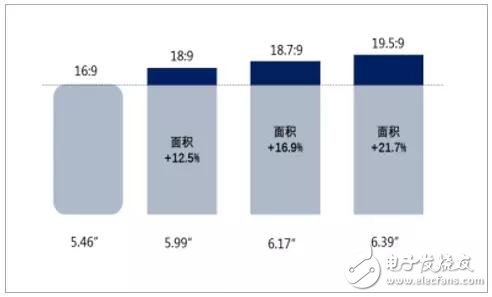
2018 major global sports events
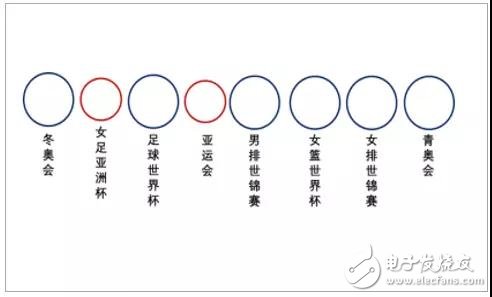
Global TFT-LCD demand forecast

TFT-LCD drives the demand for polarizers, and large-size TFT-LCD polarizers are still mainstream. Polarizer is an indispensable component of TFT-LCD imaging. The growth of its market demand is mainly dominated by the demand of TFT-LCD. The global polarizer market demand area is expected to reach 500 million square meters in 2019, of which, large-size TFT-LCD It is still the main source of polarizer demand, contributing more than 80% of the demand.
Forecast of global polarizer market demand
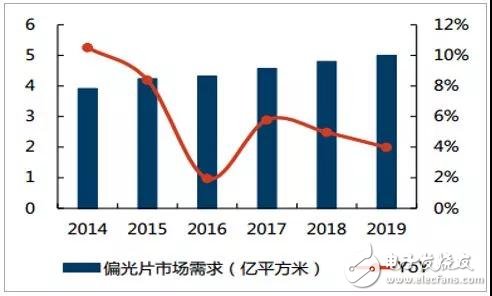
Demand structure of the global polarizer market
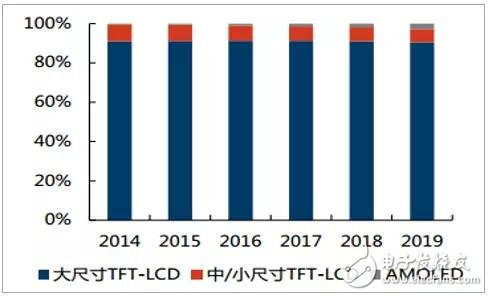
Keeping up with demand, global polarizer production capacity has steadily increased, and the supply and demand structure is relatively stable. Driven by market demand, global polarizer production capacity is gradually increasing. It is predicted that the global polarizer production capacity is expected to reach 728 million square meters in 2019. At the same time, the Glut value ((supply-demand) / demand) is 6.4% The supply is slightly higher than the demand, and the supply and demand structure is relatively good.
Global polarizer production capacity and supply and demand structure
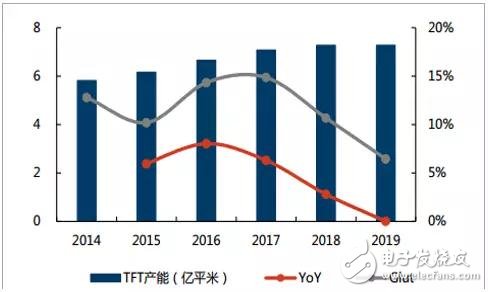
With high industry barriers, Japanese and Korean companies monopolize the global polarizer market. The polarizer industry has high technology, talents, capital and customer certification barriers, and the market concentration is high. LG Chem in South Korea, Nitto Denko and Sumitomo Chemical in Japan are trio, occupying 60-70% of the global polarizer market share. With the gradual transfer of downstream panel production capacity to the mainland, polarizer companies in Taiwan and the mainland are expected to take the lead. Representative companies are Chimei Materials, BenQ Materials, Sanli Spectrum and Shengbo Optoelectronics.
Overall, the market demand for LCD liquid crystal panels, especially in the small and medium size field, has been increasingly sensitive to prices and costs under the influence of AMOLED erosion in recent years. Against this background, jumping out of the global polarizer market monopolized by Japanese and Korean companies and cultivating their own polarizer supplier is an inevitable demand for China's panel manufacturers to gradually increase their voice in the international market.
From the perspective of the enterprise, in recent years, Sanlipu, Shengbo Optoelectronics and other companies have gradually matured their polarizer manufacturing technology level, and the production line input has begun to increase, which has formed a good connection effect with the scarce market demand. There is still a gap in the high-end field, but from the perspective of technological path and development, it is not impossible to catch up. It should be pointed out that the core raw material PVA film and other products are still mainly relying on Japanese suppliers to purchase. To achieve a truly complete domestic substitution of polarizers, the road ahead is still long and arduous, and it requires the joint efforts of more domestic upstream material manufacturers. .
Market share of global polarizer manufacturers
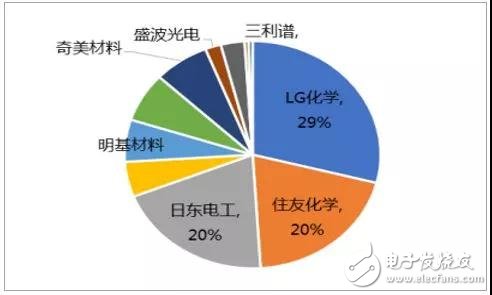
3. The transfer of panel production capacity to the mainland requires urgently the localization of polarizers
The domestic LCD production line increased year by year, and the production capacity gradually increased. Since the first mass production of the country's first 5th generation TFT-LCD production line in 2005 ended the era of China's "independent LCD", domestic LCD production lines have increased year by year. As of 2017, there have been as many as 27 LCD production lines. The production area reached 90 million square meters. Beyond Japan, form a three-legged trend with South Korea and Taiwan. The high-generation production line started, and LCD production capacity is expected to continue to increase.
At present, there are already seven high-generation LCD production lines in the country under construction, which are expected to be put into operation in 2018 and 2019, corresponding to an annual production area of ​​up to 770 million square meters, and domestic LCD production capacity expansion space is still wide. OLED display panels are gradually exerting strength, and annual production capacity is expected to increase by 7.09 million square meters in the next two years.
As of 2017, there are already 7 domestic OLED panel production lines in production or small batch trial production, with a capacity reserve of 3.94 million square meters. In 2018 and 2019, there will be six G6 AMOLED panel production lines from construction to mass production ramp-up stage. Although AMOLED's mass production ramp-up time period is longer, it is expected to add 7.09 million square meters of annual production capacity. Domestic demand for polarizers continues to grow. As mentioned above, at present, major domestic panel manufacturers have invested in the development of high-generation LCD and OLED panel production lines. Domestic panel production capacity will increase in the next two years, which will drive the increase in demand for polarizers.
TFT-LCD polarizer demand calculation: According to the ratio of LCD and polarizer area ratio 1: 2.3, as of 2017, with the full production of the TFT-LCD production line, the annual demand area of ​​polarizers reached 206 million square meters, In 2018 and 2019, the high-generation LCD production line will be gradually put into production. If the climb is smooth, it can bring annual demand increases of 0.52 billion and 126 million square meters of polarizers. The domestic TFT-LCD polarizer market space is still wide. . Domestic demand for polarizers continues to grow.
Absolute rotary Encoder measure actual position by generating unique digital codes or bits (instead of pulses) that represent the encoder`s actual position. Single turn absolute encoders output codes that are repeated every full revolution and do not output data to indicate how many revolutions have been made. Multi-turn absolute encoders output a unique code for each shaft position through every rotation, up to 4096 revolutions. Unlike incremental encoders, absolute encoders will retain correct position even if power fails without homing at startup.
Absolute Encoder,Through Hollow Encoder,Absolute Encoder 13 Bit,14 Bit Optical Rotary Encoder
Jilin Lander Intelligent Technology Co., Ltd , https://www.landerintelligent.com
